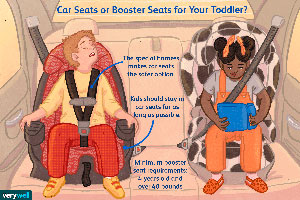What's a seat booster?
 A booster seat enables your child to use the seatbelt restraint of your vehicle, unlike a car seat that uses a five-point-harness. To "boost" them to the right height for the seat belt, your child should sit on top of a booster seat. In your car, the seat belts are built to suit adults, so when your child sits in it a booster seat mimics the height of an adult.
A booster seat enables your child to use the seatbelt restraint of your vehicle, unlike a car seat that uses a five-point-harness. To "boost" them to the right height for the seat belt, your child should sit on top of a booster seat. In your car, the seat belts are built to suit adults, so when your child sits in it a booster seat mimics the height of an adult.What age are you allowed to move to a booster seat?
The correct time to move your child to a booster seat is hard to say. At different rates, each child develops. Here are however, several general guidelines that will help you decide if your child is prepared to switch to a booster seat.
Your child weights a minimum of 40 kilos.
Your child is 4 years of age, at least.
With the seat belt appropriately fitted over the shoulder and below the hips, your child will remain in the booster seat for the entire car ride.
The inner harness or height specifications of a forward-facing five-point harness car seat have been outgrown by your kid.
Advantages of a brace of five points
Although drawing a booster seat is appealing for both parents and children, there are some obvious benefits to holding your child as long as possible in a five-point harness. They lose a layer of security each time your child graduates into the next stage of seat belt use. The five-point harness of a car seat works even better for smaller children than a booster seat with a seat belt. They will be able to step out of the correct seat belt position or even unbuckle the belt more easily when you move your child to a booster seat.
Make sure they don't put the shoulder belt behind their back or under their arm while the child is sitting in the booster seat. It's safer to use a car seat with a brace or a separate booster seat with an adjustable shoulder belt guide if they insist on doing so to be comfortable.
The whole car trip would be challenging for most kids to sit in a booster seat and keep the seat belt correctly fitted until they are around five years old. There is no hurry to move your child from a car seat with a five-point harness to a booster seat. Alternatively, encourage your child to develop out of their car seat, then make the switch to a booster seat.
Types of seats for boosters
For your kid, there are mainly two types of booster seats that you can select: a high-back booster and a backless booster.
It is easy to switch Backless boosters from one car to another. The vehicle must have a seat back high enough to provide protection behind the head of your baby while using a backless booster. What's sufficiently high? The ears of your child should be below the top of the seat or headrest of the car.
Starting with a high-back booster seat, most children are better off. The extra high back support helps remind children to sit correctly. They can help position your child's seat belt and assist children who sometimes sleep in the car so that they do not slump while sleeping.

